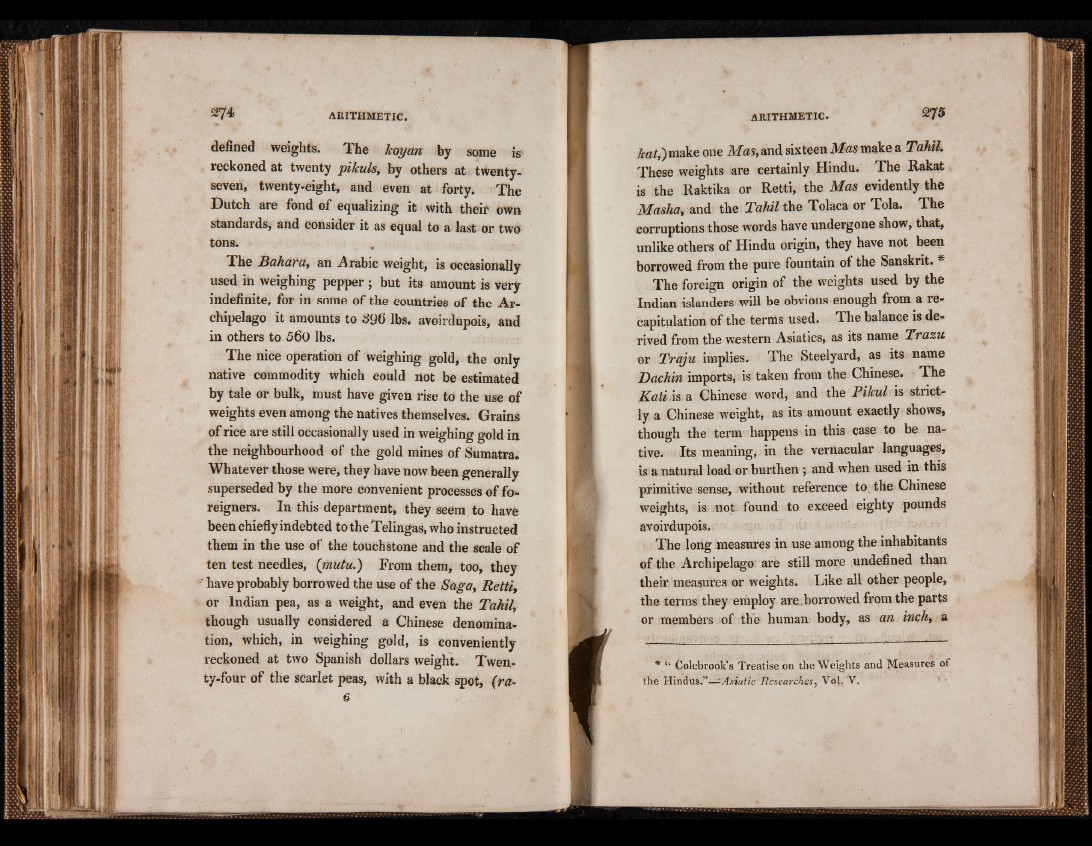
defined weights. The koyan by some is
reckoned at twenty pikuls, by others at twenty-
seven, twenty-eight, and even at forty. The
Dutch are fond of equalizing it with their own
standards, and consider it as equal to a last or two
tons. ,
The Sahara, an .Arabic weight, is occasionally
used in weighing pepper ; but its amount is very
indefinite, for in some of the countries of the Archipelago
it amounts to 396 lbs. avoirdupois, and
in others to 560 lbs.
The nice operation of weighing gold, the only
native commodity which could not be estimated
by tale or bulk, must have given rise to the use of
weights even among the natives themselves. Grains
of rice are still occasionally used in weighing gold in
the neighbourhood of the gold mines of Sumatra.
Whatever those were, they have now been generally
superseded by the more convenient processes of foreigners.
In this department, they seem to have
been chiefly indebted to the Telingas, who instructed
them in the use of the touchstone and the scale of
ten test needles, (mutu.) From them, too, they
have probably borrowed the use of the Saga, Retti,
or Indian pea, as a weight, and even the Tahil,
though usually considered a Chinese denomination,
which, in weighing gold, is conveniently
reckoned at two Spanish dollars weight. Twenty
four of the scarlet peas, with a black spot, (ra-
6
hat,) make one Mas, and sixteen Mas make a Tahil.
These weights are certainly Hindu. The Rakat
is the Raktika or Retti, the Mas evidently the
Masha, and the Tahil the Tolaca or Tola. The
corruptions those words have undergone show, that,
unlike others of Hindu origin, they have not been
borrowed from the pure fountain of the Sanskrit. *
The foreign origin of the weights used by the
Indian islanders will be obvious enough from a recapitulation
of the terms used. The balance is derived
from the western Asiatics, as its name Trazu
or Traju implies. The Steelyard, as its name
Sachin imports* is: taken from the Chinese. The
Kati is a Chinese word, and the Pikul is strictly
a Chinese weight, as its amount exactly shows,
though the term happens in this case to be native.
Its meaning* in the vernacular languages,
is a natural load or burthen ; and when used in this
primitive sense, without reference to. the Chinese
weights, is. not. found to exceed eighty pounds
avoirdupois.
The long measures in use among the inhabitants
of the Archipelago* are still more undefined than
their measures or weights. Like all other people,
the terms they employ ara.borrowed from the parts
or members of the human body, as an inch, a
* Colebrook’s Treatise on the Weights and pleasures of
the Hindus.”—-Asiatic Researches, Vol. V.